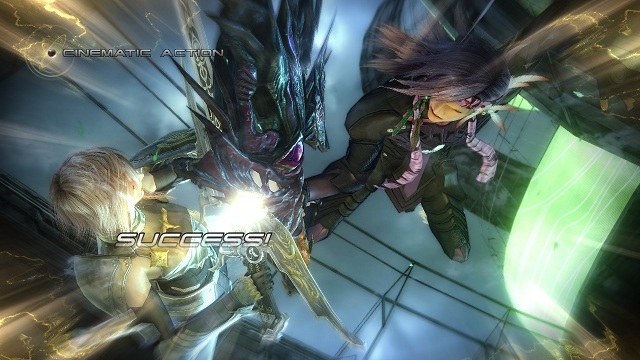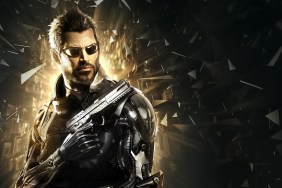Saving the world wasn’t enough—now time needs to get its ass saved too?
True story: The first time I popped Final Fantasy XIII-2 in my PS3, my dad—who’s staying with me during the winter—wandered into the living room while the opening cut-scene was playing. After a minute of flashy acrobatics, the game’s bad guy, Caius, appeared on screen, to which my dad says, “Oh, who’s that chick? She’s hot!”
Despite the sheer awkwardness of that moment, I couldn’t help but wear a knowing smile on my face. Those of us exposed to JRPGs on a regular basis tend to forget sometimes about things like the hyper-androgynous characters, but all it takes is the confusion of a less-experienced bystander to remind us once in a while of how ridiculous these things can be.
I begin with this story, in addition to sharing my amusing moment of discomfort with you dear readers, to set a particular tone for FFXIII-2: that of familiarity and predictability. There’s very little to this game that you haven’t seen before in a myriad of other JRPGs, and nothing that you haven’t seen before if you’ve played FFXIII.
That’s not to say that there isn’t anything to like here; you simply need to know your own preferences well, because like its predecessor, FFXIII-2 will be divisive as hell. I've enjoyed it for the most part, but then I also enjoyed the original. When GR was still handing out letter grades in the stone age, I gave FFXIII a B+. I still stand by that grade, because that’s how I felt, but in my young reviewing naiveté I do not think I adequately expressed how differently I expected opinions to vary on the game.
So I’m going to be up-front about it this time: Just like FFXIII, some people are going to like FFXIII-2 a lot, and some would only be happy if every disc was micturated upon and set on fire. C'est la vie. And so in the spirit of that divided population, I’m going to commit a cardinal reviewing sin, if you’ll permit me just this once, and launch into some bullet points to help determine where you lie on this spectrum.
Do check out FFXIII-2 if you:
-Liked FFXIII (duh!)
-Like monster collection and training
-Wished FFXIII had more non-linear exploration
-Enjoy over-the-top melodrama like only the Japanese can conjure up
Don’t go near FFXIII-2 if you:
-Need a plot that’s logical and coherent
-Didn’t like the battle system of the original
-Want anything resembling a traditional FF experience
-Hate over-the-top melodrama like only the Japanese can conjure up
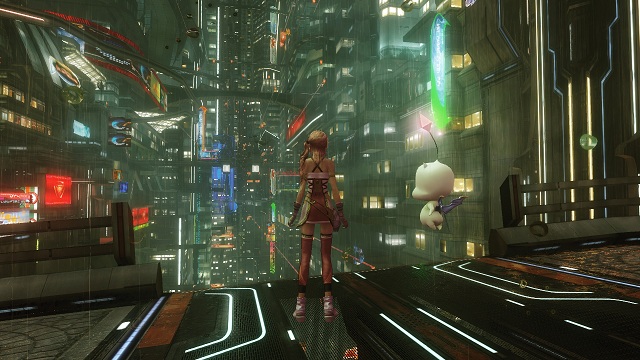
Overall, this sequel is a better game than the original for the few improvements it’s received, chiefly the move away from the incredibly dull, linear hallways that constituted at least three-fourths of the original’s locations. Both the environments and the progression of the plot are much more non-linear in FFXIII-2, alleviating my biggest gripe with FFXIII. You’re free to chase down treasure spheres in nooks and crannies while also being free to explore a ton of different locations and eras that are entirely incidental to the main storyline.
In fact, there are times when it almost seems too non-linear. The game is broken down into small areas that you can enter via the Historia Crux, which is the main hub for your time-traveling duo. More and more of those areas open up each time you unlock a new gate within one, and it isn’t long before a multitude of locations are available. Sometimes, however, it can be tough to figure out which destination you need to visit next to advance the story.
But the Historia Crux is a good vehicle, overall, for the way the game is designed. It’s more episodic in nature, with our protagonists’ lengthy trip peppered with detours to places where they must eliminate the paradox from that region before stepping back into the flow of time to find another mess to clean up. This can often mean revisiting the same place in different eras when natural occurrences that may have or have not happened yet can affect how much you can explore.
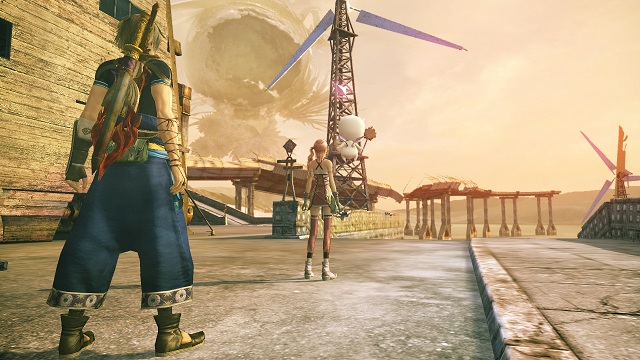
And speaking of those protagonists, it’s high time we touched on them. You’ll remember Serah, Lightning’s trapped little sister, from FFXIII. Noel is a time-traveling Sora look-alike who claims to be from a future that’s all but destroyed. Something is amiss right away when Serah seems to be the only one with memories of the true FFXIII ending—everyone else [SPOILERS] remembers Lightning also being frozen in crystal along with Vanille and Fang. But Serah still has dreams of Lightning in a place called Valhalla on the edge of time, locked in an eternal struggle with Caius.
After Noel appears with tales of having been to Valhalla and sent by Lightning to help Serah travel through time to reach her sister, Serah ups and leaves with Noel into his time-traveling gate (which thankfully isn’t a euphemism for “his unmarked white van”). Thus begins an utterly convoluted plot which makes less and less sense the more details are revealed about time-traveling and paradoxes in the FFXIII universe.
Serah and Noel make for average protagonists; not especially likable, although they aren’t nearly as bad as some others I’ve seen. The fault lies in more with the way the plot unfolds. Like FFXIII, valuable information is conveniently withheld or waylaid until just the right moment, and it just makes the characters come off unrealistic. Noel seems to be strongly acquainted with Caius, but Serah continuously refuses to press him for information because she “knows it’s personal”. Hey, you pink-haired idiot, this guy may have important information about the bad man who could quite possibly threaten the entire space-time continuum! Fuck his boundaries, doesn’t the safety of the goddamn universe weigh a little heavier than respecting one guy’s personal space?
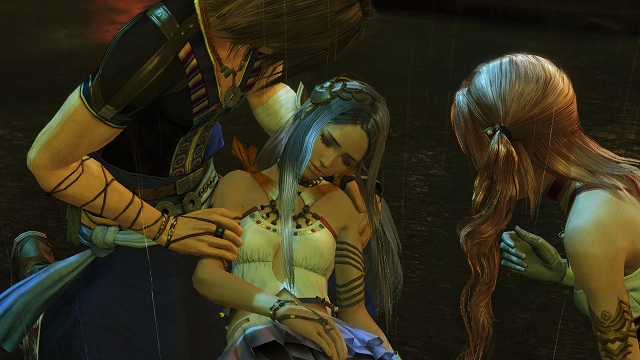
*Ahem*…Anyway, if you suspend disbelief enough for the plot, the gameplay is strong enough to hold the rest of the game up. I loved the battle system in FFXIII, but the only problem was that it took a good 15 hours to unlock enough roles and abilities to achieve the depth and nuance of which it was capable. You have early access to enough abilities (mostly those of the Saboteur and Synergist) in XIII-2, however, that you can start strategizing against difficult enemies very quickly.
If you didn’t like the FFXIII battle system, though, you won’t be enamored with this one either. It’s nearly identical, with a few small balance changes. One clear improvement is that you no longer automatically lose if your party leader is KO’d, instead switching control to the other character (which you can also do manually at any time, to boot). A few "cinematic action" events in some battles (read: God of War QTEs) break up the action, but don't have a very serious impact in the grand scheme of things. By far the most significant difference is that the third party member is going to be a monster from your collection.
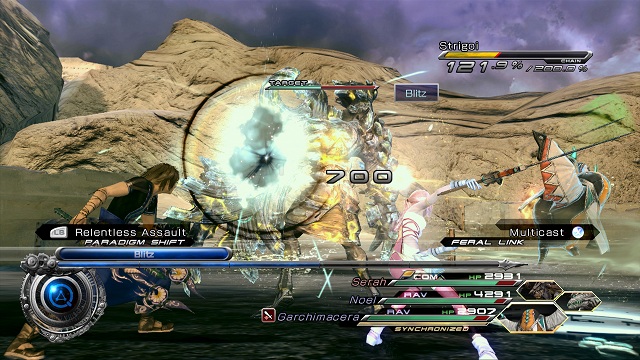
Adding a monster collecting element to any game gives it a huge boost for completionists out there, but it’s implemented well enough into XIII-2 that even those who don’t care for that type of thing shouldn’t be turned off. Monsters have a chance to join your party when you defeat them in battle, with a higher chance if you kill them with a “feral link” attack, which is a special move of the monster you currently control. You can add up to three monsters to your party, which will factor into your paradigms.
That can be a little constricting, at times, because it makes it harder to create a varied set of paradigms in this game than it was in the original. Each monster has an innate role, which means that third party member slot can only ever be one of the three roles of the monsters you’re currently using, as opposed to a complete third character with access to every role like in FFXIII. On the other hand, this also requires you to think about your strategy a little harder before charging into battle and encourages you to play around with your party makeup more often.
While Noel and Serah grow through the good old Crystarium once again, monsters have their own version of the Crystarium that Square-Enix has impressively designed uniquely for each individual monster in the game. The method is slightly different—advance them with special items that drop from battles rather than with the CP won from battles—but it amounts to the same idea.
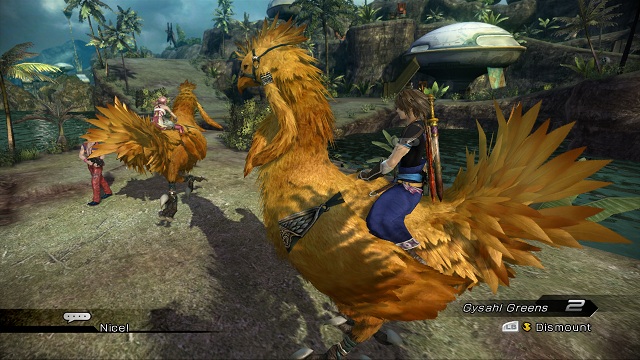
On top of that, monsters can be “infused” with other monsters, which really means eating them to learn their passive abilities. This also opens up a lot of room for customization, as you can tailor your monster of choice to have the abilities you want on it. There are even some secret abilities that only appear when you infuse particular combinations into a monster. Just be careful, because any monster used for infusion will have to be re-caught at level 1 if you want it back.
For added replay value, there’s also a casino called Serendipity where you can play slots and race chocobos. Yes, chocobo racing is back, and you can use and grow the chocobos that you’ve caught for your party, but unfortunately it’s not as fun or useful as the racing from FFVII. There will be card games added to the casino through DLC, as well as what’s promised to be some titanic optional bosses in the Coliseum.
So at the end of the day, I’m going to say what I expected to say when I saw this game in the past, and what you probably expected me to say as well: FFXIII-2 is a lot like FFXIII and will elicit the same kind of divided response within the gaming community. It is slightly better, all things considered, with a few appreciated improvements, but it certainly isn’t anything that’s going to sway someone who didn’t like FFXIII to begin with.
-
It’s a lot like FFXIII
-
Battle system returns with a few nice tweaks
-
Monster collection and growth is well done
-
A return to non-linear exploration
-
…perhaps too non-linear
-
Convoluted and nonsensical plot
